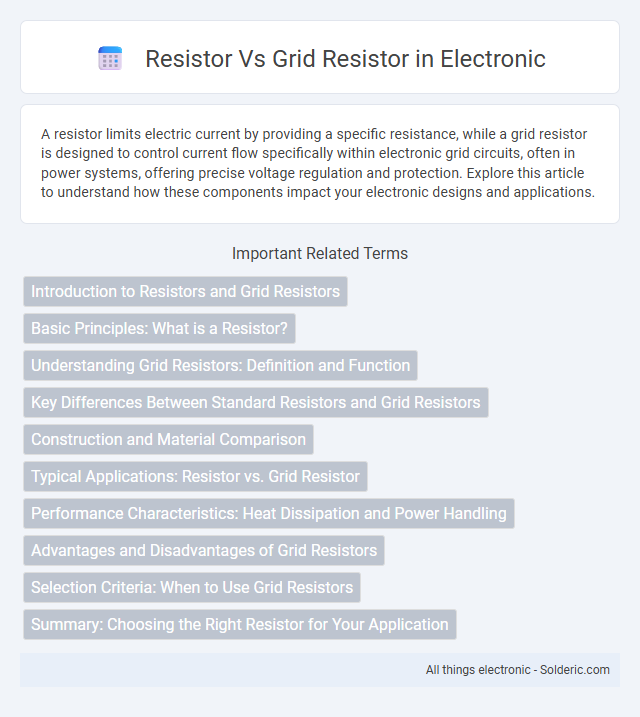A resistor limits electric current by providing a specific resistance, while a grid resistor is designed to control current flow specifically within electronic grid circuits, often in power systems, offering precise voltage regulation and protection. Explore this article to understand how these components impact your electronic designs and applications.
Comparison Table
| Feature | Resistor | Grid Resistor |
|---|---|---|
| Definition | Passive electrical component limiting current | Special resistor used in power grids to control fault currents |
| Application | General electronic circuits | Electric power transmission and distribution systems |
| Power Rating | Typically low to moderate (mW to W) | High power rating (kW to MW range) |
| Construction | Carbon, metal film, wire-wound | Robust wire-wound or grid-shaped resistive elements |
| Purpose | Control voltage/current in circuits | Dissipate fault current energy, stabilize grid operation |
| Thermal Management | Standard heat dissipation methods | Advanced cooling systems (air/water-cooled) |
| Cost | Low to moderate | High due to size and power handling |
Introduction to Resistors and Grid Resistors
Resistors regulate electrical current by providing specific resistance levels to control voltage and current flow in circuits. Grid resistors, a specialized type of resistor, consist of a resistive wire grid designed to handle higher power dissipation and improve heat distribution in industrial or high-power applications. By understanding the differences, you can select the right component to optimize your circuit's performance and durability.
Basic Principles: What is a Resistor?
A resistor is a passive electrical component designed to limit or regulate the flow of electrical current in a circuit by providing a specific amount of resistance measured in ohms. Grid resistors, often used in electrical power distribution and traction systems, are specialized resistors arranged in a grid-like pattern to dissipate large amounts of power as heat while maintaining uniform resistance and enhanced heat dissipation. Understanding the basic principle of resistance helps in differentiating standard resistors used for current control from grid resistors engineered for high-power applications and effective thermal management.
Understanding Grid Resistors: Definition and Function
A grid resistor is a specialized type of resistor designed to limit current and control voltage within electrical grid systems, ensuring stable operation of power distribution networks. Unlike standard resistors used in general electronic circuits, grid resistors are engineered to handle high power levels and dissipate large amounts of heat efficiently. Understanding the function of a grid resistor helps you optimize grid reliability by preventing overloads and improving system protection.
Key Differences Between Standard Resistors and Grid Resistors
Standard resistors provide fixed resistance values for controlling current in electronic circuits, using materials like carbon or metal film. Grid resistors differ by incorporating a wire-wound or perforated grid structure that enhances heat dissipation and power handling capabilities. The primary distinction lies in grid resistors' ability to withstand higher power loads and reduce thermal stress compared to standard resistors.
Construction and Material Comparison
Resistors typically consist of a metal film, carbon composition, or wire wound around a ceramic core, whereas grid resistors (or grid power resistors) use ceramic or metal oxide resistive elements embedded in a robust insulating grid structure. The construction of grid resistors emphasizes heat dissipation and mechanical durability with their grid framework, while standard resistors prioritize compactness and precision. Materials in grid resistors are selected for high power handling and thermal stability, contrasting with the variety of materials chosen in standard resistors for different resistance values and tolerance levels.
Typical Applications: Resistor vs. Grid Resistor
Resistors are commonly used in electronic circuits for current limiting, voltage division, and signal conditioning, making them essential in devices like power supplies, amplifiers, and sensors. Grid resistors, designed with a grid-like structure for better heat dissipation, are typically applied in high-power environments, such as industrial motor controls, braking systems, and load banks, where managing thermal stress is critical. Choosing the right component depends on your application's power handling and thermal management requirements.
Performance Characteristics: Heat Dissipation and Power Handling
Grid resistors excel in heat dissipation due to their open-frame design, allowing better air circulation compared to standard resistors. Your choice should favor grid resistors when high power handling is essential, as they can endure greater load without overheating. Standard resistors, while compact, often have limited power ratings and may require additional cooling in high-performance applications.
Advantages and Disadvantages of Grid Resistors
Grid resistors offer superior heat dissipation and compact size compared to traditional wire-wound resistors, making them ideal for high-power applications. They provide precise resistance values with better thermal stability but typically have higher costs and lower availability. However, grid resistors can be more prone to damage from mechanical stress and require careful mounting to avoid performance degradation.
Selection Criteria: When to Use Grid Resistors
Grid resistors are primarily used in high-voltage applications where current limiting and energy dissipation are critical, such as in power supplies and cathode ray tubes, while standard resistors suit low-power, general-purpose circuits. When selecting grid resistors, consider parameters like power rating, voltage tolerance, and thermal management to ensure reliable performance under high stress. Your choice depends on the operating environment and required durability, with grid resistors offering superior resilience to voltage spikes and heat compared to conventional resistors.
Summary: Choosing the Right Resistor for Your Application
Selecting the right resistor for your application depends on factors such as power rating, tolerance, and environmental conditions. Standard resistors are suitable for general-purpose circuits, while grid resistors, with their robust heat dissipation and higher power handling capabilities, are ideal for high-current or industrial applications. Understanding these distinctions ensures optimal performance and longevity in electronic designs.
resistor vs grid resistor Infographic

 solderic.com
solderic.com